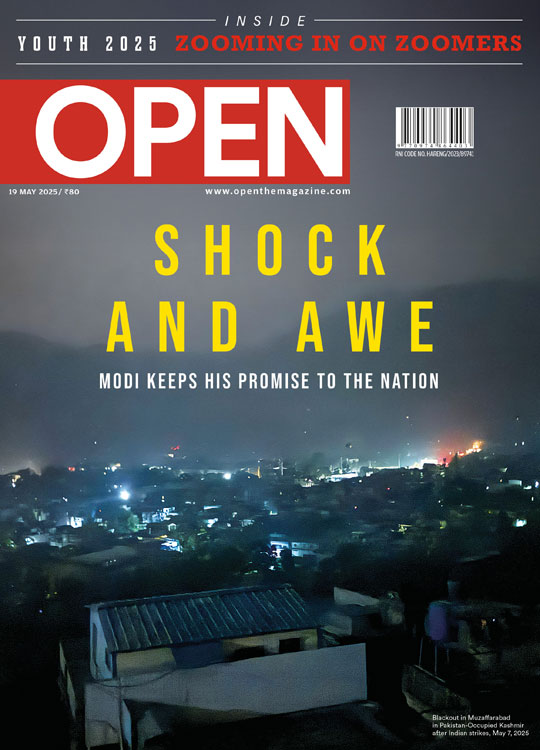Eastern Promises
An underground movement is afoot among Indian shoppers looking for cheap and exciting finds on Chinese websites
/wp-content/uploads/2018/09/Easternpromises1.jpg)
WHAT A TIME TO BE ALIVE. Make a wish into the prismatic well of your cellphone screen and it shall come true. Anti-cellulite vacuums to suck the butter-cream cake right out of your love handles? Creepy ‘reborn baby’ dolls to cope with neonatal loss? Vape pens sexier than a dangling cigarette? Melamine foam pads you can slough off the toughest grime with? Or just a cute hair accessory that looks like a pair of scissors? Yes, please. The internet knows your foibles and indulges your secret vices. The Indian consumer, weaned on teleshopping, has steadily marched to newer territories, both offline and online, and acquired a fluid sense of self: from malls stocked with outdated American fashion and European shoes a click away, to used luxury bags, books and gadgetry stacked in the discount aisles of Amazon and Flipkart, and chic boutiques that sucker you in through your social media feed. The latest frontier is a tricky one: China, that pulsing postmodern bricolage of mass culture. A generation of Indians talked in hushed tones of their forbidden romance with it, or with an air of curdled cynicism towards all things Chinese, until the era of mass-produced electronics and Android phones turned the price-quality tradeoff argument on its head. “The stigma around Chinese products has all but faded, thanks to the collective goodwill earned by Oppo, Xiaomi and other Chinese companies. Indians are more willing than ever to buy Chinese goods—from clothes and shoes to lifestyle products—even without active marketing or rebranding by importers,” says Anindito Chatterjee, an economist and researcher at Tsinghua University, Beijing, and a consultant for Chinese brands and startups looking to enter India. “The most important personal possession of our times, the smartphone, is a Chinese preserve. The irony of worrying about using that phone to shop for Chinese-made goods should not be lost on anyone.”
Dip a toe into the world of Chinese ecommerce and you begin to find shopping on Indian apps “claustrophobic”, says Bhavna Naik, a 35-year-old marketing manager from Powai, Mumbai. “It is not just about the price. Indian online marketplaces are still propagating brand culture, ignoring all the cooler generic stuff out there that’s making waves across the world. I wanted a long windbreaker to wear over a dress—a hot trend across global runways. But you can’t find one on Myntra or Amazon. I ordered it for $18 on AliExpress even if it meant I would wait a month for it to arrive. It is my go-to source for everything from cheap beauty dupes to gift bags and eco-friendly use-and-throw house slippers,” Naik says. “Everything you ever wanted from America, cheaper and better. Just learn to avoid scamsters.” Naik also swears by no-name chargers and adapters from banggood.com, a Chinese marketplace specialising in consumer electronics. “They have outlasted genuine iPhone accessories,” she says.
AliExpress, Chinese ecommerce behemoth Alibaba’s West- facing app, grew by 80 per cent between 2016 and 2017, according to app market data research company AppAnnie—from 28 million to 50 million iOS and Google Play downloads worldwide. AppAnnie notes that AliExpress is among the top five shopping apps in the UK, Australia, France and Germany, and that it is expanding its footprint in emerging markets like India, Russia and Turkey. The number of online shoppers in India could more than double to 120 million this year, according to a recent ASSOCHAM- Resurgent study, and even that only accounts for a quarter of Indian internet users. Alibaba was unreachable for comment on how it plans to tap this market, but a former India executive said the company doesn’t want to ruffle any feathers by seeming to compete with Flipkart—in which Walmart has acquired a majority stake—and Amazon. Alibaba has a lot at stake here, having pumped in $1.7 billion in investments into Paytm, BigBasket, Snapdeal, Zomato and other new economy companies.
“Everything you ever wanted from America, cheaper and better. Just learn to avoid scamsters” – Bhavna Naik, marketing manager, Mumbai
Often aimed at wholesalers and dropshippers, Chinese marketplaces are vast repositories of everyday things, some life-altering and others mundane, and you could get lost in them for hours—or find yourself anew. The tyranny of choice—said no millennial ever. “There is something in there for everyone,” says Anubha (last name withheld on request), a 28-year-old product manager with an IT company in Gurgaon. “You scroll through AliExpress and you come back with things you didn’t know existed. It’s a nice feeling, the sense of discovery.” After suffering a miscarriage in her sixth month of pregnancy last year, Anubha, in a bout of depressive shopping, made dozens of purchases on Chinese websites including dhgate.com and AliExpress. “I was buying hair extensions that I’d never use, and cycling gear, even though I hadn’t cycled in three years, because these items were trending on Pinterest and I wanted to feel woke. But one day, I searched for ‘dolls’ on AliExpress and I was shocked at the range of ‘reborn dolls’ that looked like real babies. I bought one for Rs 550, and when I told my husband, he was alarmed. It arrived a month-and-a-half later, a pink 22-inch-long baby made of silicone. It felt freaky to the touch, but having it around the house was nice somehow, even therapeutic. It made me realise there were countless other parents who had gone through what we had.”
Most purchases on AliExpress tend to be cheap and frivolous, but that is not to say buyers of popcultural ephemera don’t share a sense of community. Fourteen-year-old Anaya Raghu, whose parents recently relocated from Florida to Chennai, loves making slime. Slime, if you didn’t know, is a malleable modelling clay that is enjoying a wild surge in popularity, like fidget cubes. It is usually made from glue, borax, water, colour and an activator that turns the mixture into the sticky stuff of adolescent dreams. “Slime ingredients are available on Amazon, but there are not many options. Mom lets me order them from AliExpress, where I also buy other craft supplies,” says Raghu, who is not allowed to install shopping apps on her phone. “I love chatting with slime sellers on AliExpress. Sharing ideas and recipes is part of the buying experience. A lot of times, their English isn’t great but it’s enough to communicate. Mom doesn’t mind it because I shop only in the weekends and I stick to a budget,” she says, claiming she saved $39 on craft supplies in the past month by buying directly from cheap suppliers.
“Jack Ma is someone I really admire. I can’t say the same thing about Jeff Bezos,” says Geetha K Wilson, a 31-year-old communication officer and research associate with a thinktank in Bengaluru that studies Vembanad Lake. She is only half-joking when she says she is tired of Amazon’s choice of American brands and prefers to slalom through the fakes and the defective pieces on AliExpress for value-for-money finds. An underwater camera she bought for Rs 3,000 for official use did the job just as well as a GoPro Hero that sells for Rs 17,000, she says. Having discovered AliExpress a year ago thanks to a colleague, Wilson has bought replica Wacom tablets for a fraction of the price, cutesy accessories for the grand sum of Rs 40, winter boots and clothes. “I look for genuine reviews and 4.7-plus ratings and I have never been disappointed. I wouldn’t advise you to buy clothes on AliExpress though—the sizes are always too small. Even at Rs 300-500, they are not worth it.”
THE WESTERN AESTHETIC feels jaded and overdone, and as a result, cult Asian brands like MUJI, which have a simplistic design ethic, are growing in popularity in India, says Aprameya Radhakrishna, a Bangalore-based entrepreneur and investor. “The same thing is happening with Indian ecommerce. There are two types of customers who may be growing disenchanted and looking for Chinese alternatives. The large number of not-so-brand-conscious consumers who want value and can’t find discounts that are deep enough. And the other kind who occupy a smaller niche and find products on Indian shopping apps too mainstream.” Radhakrishna says he has heard a few startup pitches around dropshipping and collective warehousing aimed at minimising global stocking inefficiencies.
“Six years ago, I ordered expensive equipment from AliExpress on which I was charged duty. It was still a bargain because these components were hardly available in India” – Sony Sasankan, video editor and cryptocurrency miner
If you are an AliExpress addict window-shopping at the chi-chi home design stores of Indira Nagar, one of Bengaluru’s upscale commercial districts, you may find yourself momentarily consumed by ungovernable anger at the faux flowers, tea caddies and filament bulbs retailing at up to 300 per cent mark-ups over AliExpress prices. “The reason apps like AliExpress are potentially dangerous is that they disrupt local margins and make it easy for individuals to import products—even banned and unsafe items—without paying duty,” says Sanchit Vir Gogia, chief analyst at Greyhound Research. “The Government of India is focused on boosting manufacturing and all its policies are geared towards this. Right now, the use of AliExpress in India is still a distributors’ movement and not a full-fledged consumer movement. The Government and ecommerce players are watching it closely.” Importers have long undervalued goods from China to evade duty—only, the modality of it has changed with trade moving online. When you buy an item on AliExpress, the seller will typically undervalue it heavily so you wouldn’t have to pay customs duty upon delivery. But if you are unlucky, you may get a call from the local post office to let you know that your package, flagged due to size, bulk or the nature of the contents, will be released only after you pay a fee. According to a postal circular issued in June 2018, bona fide imports valued under Rs 5,000 and meant for personal use are exempt from duty. But it is a far-from-perfect system. “The basic prerequisite for release of goods, namely, filing of declaration and deposit of duty, cannot be provided with any consistency in the current postal environment,” the circular notes.
International shipping is no longer unfamiliar terrain for Indian shoppers, but six years ago, when Sony Sasankan, a video editor and cryptocurrency miner, started ordering expensive equipment from AliExpress, no one knew what to expect. The order included cables, connectors, power supply units and computer components totalling about Rs 45,000, on which he was charged duty of about Rs 10,000. “It was still a bargain because these components were hardly available in India. They would have cost me Rs 2 lakh had I gone through Indian suppliers. The few sellers who were early in the game had outrageous prices and capitalised on the fear of people who never played around with international shipping. There were lots of variables. No one knew what was legal or illegal, or whether the sellers would run away with the money, would the product get stolen on the way etcetera. There was a kind of safety net to order within India on familiar platforms like eBay, Flipkart and Amazon. Accountability was easier to enforce, and they preferred to pay a premium than risk losing money.” AliExpress is now a lot more user-friendly and has a reasonable complaint redressal mechanism—a forum where buyer, seller and negotiator discuss disputes, upload proof of damaged items or wrong colour/size and come to an agreement on whether to replace, return or refund.
Sasankan, 36, works out of a flat in south Bengaluru, his room crammed to the brim with mining machines that have fallen silent now that it is no longer viable to keep them running. This is also where he edits videos—feature films and documentaries that sometimes call for unique props. “I was working on a Tamil movie and a certain scene called for a fancy sniper rifle and several assault rifles. In the movie industry, you usually rent out gun props but they are usually small handguns. Bigger guns are rare and expensive and they look quite fake. So we were in quite a fix. I went looking for some good quality plastic guns on AliExpress. One thing led to another and I came across highly detailed arts and crafts gun model layouts. They are supposed to be cut out with a scalpel along dotted lines, folded and pieced together into a realistic full-sized gun. Fragile paper guns—who would have thought!” he says, pointing me to simulation M200s and M416s retailing for under $25 on AliExpress.
This underground movement is finding new takers in engineering students looking for Arduino microcontroller starter kits for that forgettable college project, fashionistas hopping from Instagram to Tinder, even 65-year-olds who have tired of watching cat videos and want to bask in the age of eroded frontiers. Ashok M, a retired electrical engineer from Chennai, likens shopping on Chinese sites to eating a burger. “At my age, these are guilty pleasures I occasionally allow myself. But if I don’t like it—the video rig for my iPhone that I bought for $10 on AliExpress or the gourmet bean burger that cost me almost as much—I will leave a virulent review.”

/wp-content/uploads/2025/05/Cover-War-Shock-1.jpg)















More Columns
India hammers Pak air bases at Rafiqui, Murid, Chaklala, and Rahim Yar Khan in a show of unflinching force Open
How India (re)built its defence preparedness and war readiness V Shoba
Cracks in the Pink Fortress Open